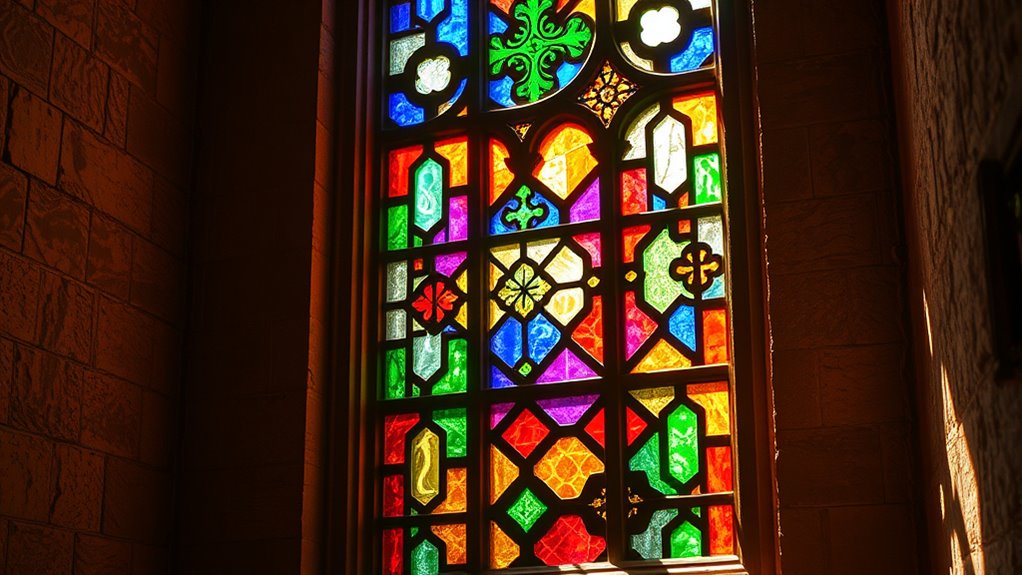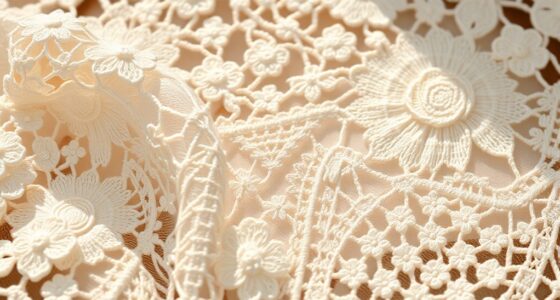To decode secret messages in stained-glass windows, focus on the symbolism behind colors, imagery, and placement. Recognize that each element often represents biblical stories, moral lessons, or political messages, all influenced by their historical context. Pay attention to how specific colors like red or blue convey deeper meanings, and consider the cultural or political climate when the window was created. Continue exploring to uncover the rich stories and hidden insights these vibrant windows hold beneath their beauty.
Key Takeaways
- Analyze the colors and imagery to interpret symbolic meanings rooted in historical, religious, and cultural contexts.
- Consider the era and community when the window was created to understand the intended messages.
- Recognize that symbols often encode moral lessons, biblical stories, or political messages beneath their visual appearance.
- Observe the placement, size, and hierarchy of images to discern their significance and hidden narratives.
- Be aware of cultural and political influences that may embed subtle social commentary or ideological messages within the design.

Have you ever wondered if stained-glass windows hold secret messages beyond their stunning colors? These vibrant masterpieces are more than just decorative elements; they’re carefully crafted stories, woven with symbolism analysis and historical context. When you look at a stained-glass window, you’re not only admiring the artistry but also engaging with layers of meaning that reveal insights into the past. Understanding the symbolism woven into these windows can transform your appreciation from mere aesthetic admiration to a deeper exploration of history, religion, and culture. Historical context plays a vital role here, as it helps decode the symbols and motifs that might seem cryptic at first glance. For example, certain colors and imagery were used deliberately to convey specific messages, often tailored to the audience of the time, many of whom might have been illiterate. Red could symbolize both love and martyrdom, while blue often represented heaven or divine wisdom. Recognizing these color choices requires an understanding of the historical period when the window was created, as meanings could shift over centuries. Additionally, understanding the cultural significance of certain symbols can provide further clarity on their intended message. As you analyze the symbolism, you’ll notice that many images serve dual purposes. Some depict biblical stories, but others subtly encode moral lessons or political messages. For instance, a depiction of a lamb might symbolize Jesus Christ, but it could also serve as a reminder of innocence or sacrifice. The placement and size of figures further emphasize their importance, guiding your eye and highlighting key messages embedded within the design. To truly decode these messages, you need to take into account the historical context in which the window was made. Was it commissioned by a church seeking to educate its congregation? Or perhaps it was created during a time of political upheaval, with certain symbols subtly criticizing or supporting specific factions? Knowing the era and the community’s beliefs helps you interpret the icons more accurately, revealing what the artists intended to communicate.
Frequently Asked Questions
How Did Stained-Glass Window Symbols Originate Historically?
You might wonder how stained-glass window symbols started. Historically, medieval iconography and religious symbolism played a key role. Artists used these images to tell stories and inspire faith, especially when many couldn’t read. These symbols, like saints and biblical scenes, communicated powerful messages. Over time, they became an essential part of church architecture, helping worshipers understand spiritual lessons through vivid, visual storytelling embedded in stained-glass windows.
Are There Specific Patterns Unique to Particular Regions or Churches?
Imagine stepping into a church where each stained-glass window whispers secrets of its own. You’ll notice regional motifs that paint local stories and church-specific symbols that carve out unique identities. These patterns act like visual fingerprints, revealing traditions and beliefs. As you explore, you realize each region and church crafts its own language of light, making every window a personalized tapestry of faith and history, waiting for you to decipher its hidden message.
What Tools Do Experts Use to Analyze Hidden Messages?
You might wonder what tools experts use to analyze hidden messages. They often rely on digital imaging to capture detailed images of stained-glass windows, revealing subtle details unseen by the naked eye. Spectral analysis helps identify different materials and pigments used, uncovering clues about the messages’ origins. These techniques allow experts to decode secret symbols and inscriptions, providing insights into historical and artistic contexts.
Can Stained-Glass Windows Contain Messages in Different Languages?
You might wonder if stained-glass windows contain messages in different languages. Yes, they can feature medieval iconography and linguistic symbolism, reflecting diverse cultural influences. Artists often used these elements to convey spiritual or historical messages understandable to viewers of various backgrounds. By examining symbols, inscriptions, and stylistic details, you can uncover hidden meanings across different languages, revealing the rich, multicultural stories embedded in these stunning windows.
How Do Restoration Processes Affect the Original Hidden Messages?
Investigating the theory that restoration impacts message preservation, you find that careful restoration can protect these hidden messages. However, aggressive or poorly executed processes risk erasing or distorting them. You should always prioritize gentle techniques to maintain the stained-glass windows’ original features. Ultimately, thoughtful restoration ensures the message remains intact, preserving the historical and artistic significance for future generations. Proper care balances renewal with the integrity of the original hidden messages.
Conclusion
So, next time you’re admiring those dazzling stained-glass windows, remember—they might just be whispering secret codes, not just pretty pictures. Who knew that centuries of religious artistry also served as ancient spy messages? It’s almost poetic—art hiding secrets while we marvel at its beauty. So go ahead, decode away. Just don’t be surprised if you find yourself questioning whether stained glass is really just holy decoration or the world’s oldest encrypted gossip column.











